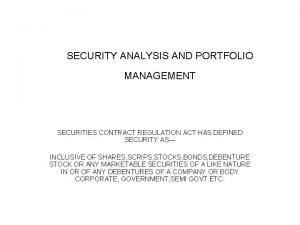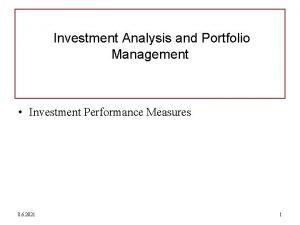Investment Analysis and Portfolio management Lecture 30 Course















- Slides: 15

Investment Analysis and Portfolio management Lecture: 30 Course Code: MBF 702

Outline • RECAP • • • CAPM – ALPHA VA VALUES CONTINUED ADVNATGES AND DISADVANTAGES OF CAPM TO APPLY THE ADJUSTED PRESENT VALUE APPROACH TO DECISION MAKING RISK ADJUSTED WACC CHOSSING A DISCOUNT RATE MERGERS AND ACQUISIITIONS VENTURE CAPITAL • •

Alpha factor - CONTINUED When shares yield more or less than their expected return (based on the CAPM), the difference is an abnormal return. This abnormal return might be referred to as the alpha factor. The alpha factor for a security is simply the balancing figure in the following formula: α values are temporary values as arbitrage gain opportunities / speculation will over a long period of time cause securities to offer the same return as that offered by a market portfolio (become inline with market). For projects with similar investment requirements & expected returns than the project with lowest β should be selected

Example The return on shares of company A is 11%, but its normal beta factor is 1. 10. The risk-free rate of return is 5% and the market rate of return is 8%. There is an abnormal return on the shares:

Illustration An investor tries to buy shares or bonds for his portfolio that provide a positive abnormal return. He is considering two shares and two bonds for adding to his portfolio. The required return on shares is measured by the Capital Asset Pricing Model (CAPM). The required return for bonds is measured using a model similar to the CAPM, except that the ‘beta’ for a bond is measured as the ratio of the duration of the bond in years to the duration of the bond market as a whole.

The first step is to calculate beta factors for the shares and the similar factors for the bonds. For shares, the beta factor is calculated as the correlation coefficient multiplied by the standard deviation of returns for the share, divided by the standard deviation of market returns. We can now calculate the required return for each security (using the CAPM) and compare it with the expected actual returns. The difference is the abnormal return. For bonds, the redemption yield should be used as the measure of return.

• Only bond P offers a positive abnormal return. If the investor makes investment decisions on the basis of abnormal returns, he will invest in this bond add it to his portfolio. (However, the abnormal return could be eliminated by a rise in the price of the bond. )


Advantages and disadvantages of the CAPM • • • The CAPM is based on some simplifying assumptions. For example, the CAPM assumes: A perfect capital market Uniformity of investor expectations All forecasts (expectations) are made in the context of just one time period. In spite of these simplifying assumptions, the CAPM appears to be reliable in practice.


ADJUSTED PRESENT VALUE (APV) Adjusted Present Value (APV) is an extension of MM theory with taxation APV & NPV give the same result when the gearing level remains same However, when financial risk changes NPV method requires the calculation of Risk adjusted WACC APV method is superior & facilitates the calculation of a revised NPV by making certain adjustments to Base Case NPV • It is often described as the “divide and conquer” approach in that it separates the “base” benefits of the project from its “side-effects”. APV is calculated as = Project value if all equity financed + Present value of the + Present value of tax shield from the loan other side effects

Approach

It is important to note that the NPV calculated using both the conventional method & the APV method may not always be equal because of the following reasons: In the conventional method NPV is calculated by discounted all the relevant cash flows with WACCg, hence all the aforementioned adjustments are incorporated into WACCg determination with the exception of spare debt capacity & subsidized debt which can only be incorporated here.

Risk Adjusted WACC • • • Identify the business risk of the project , if similar to existing operations use the current βa, if project involves diversification determine the βa Identify financial risk (D: E) ratio of the project. In absence of project specific (D: E) ratio we assume that the project will be financed form the exiting pool of funds therefore the existing D: E ration of the company may be used. Using βa & D: E of the new project calculate βe.

Thank you
 Investment analysis and portfolio management course
Investment analysis and portfolio management course Investment analysis and portfolio management
Investment analysis and portfolio management Scope of investment analysis and portfolio management
Scope of investment analysis and portfolio management Investment analysis & portfolio management
Investment analysis & portfolio management Fixed investment and inventory investment
Fixed investment and inventory investment 01:640:244 lecture notes - lecture 15: plat, idah, farad
01:640:244 lecture notes - lecture 15: plat, idah, farad Security analysis and portfolio management project
Security analysis and portfolio management project Security analysis and portfolio management project
Security analysis and portfolio management project Importance of security analysis and portfolio management
Importance of security analysis and portfolio management Risk in security analysis and portfolio management
Risk in security analysis and portfolio management Course title and course number
Course title and course number Type of portfolio
Type of portfolio Half brick wall in stretcher bond report
Half brick wall in stretcher bond report Chaine parallèle muscle
Chaine parallèle muscle Project planning and management lecture notes ppt
Project planning and management lecture notes ppt Real estate financial analysis
Real estate financial analysis



























